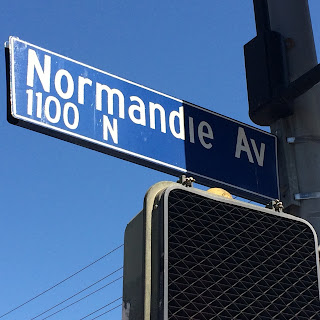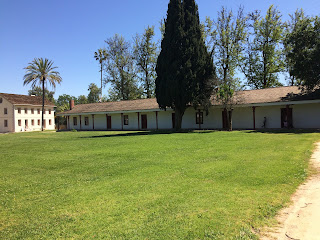Moving on to the next historic location in the Valley, we find a very special property that many Angelenos don't even know exists.
Los Encinos State Historic Park is all that remains of Rancho Los Encinos (sometimes called Rancho El Encino). The original rancho was established by Francisco Reyes (first alcalde, or mayor, of Los Angeles), re-granted to three Tongva ranchers by Pio Pico (Reyes allegedly mistreated his Native American ranch hands), sold to the de la Osa family, and sold to a Yankee named Thompson...who sold it to Philippe and Eugene Garnier in 1869.
The Garnier brothers were the first of four French families to own the property.
Philippe Garnier, Gaston Oxarat, Simon Gless, and Domingo Amestoy.
Former residents. Note the prevalence of Basque surnames.
The original de la Osa adobe house.
This is the second oldest structure in the Valley - and the only one that is pretty much unaltered.
Philippe Garnier's shaving stand.
Gaston Oxarat's saddle. This finely tooled piece was originally covered with tiny silver conchas (shells).
Juanita Amestoy wore this beautiful gown when she married Simon Gless.
Don Vicente de la Osa had previously turned the adobe into a stagecoach stop and roadside inn. The Garnier brothers, being from France, kicked the hospitality up a notch.
The Garniers had one of the adobe's rooms painted with beautifully detailed faux marbre panels.
Can you believe some idiot PLASTERED OVER these stunning walls? For over a century, no one knew this fine paint job was even there.
Try, if you can, to let your imagination fill in the blanks. It's a beautiful room now - it must have looked even better then.
I do hope someone else takes the time to notice that the plastic food on the table is French in theme. (Why is there a red candle? Did red paraffin even exist in the 1870s?)
The Northridge earthquake of 1994 severely damaged the adobe (one outer wall caved in, requiring extensive repairs). However, there was one silver lining: the earthquake may have damaged the house, but it shook much of the offending plaster right off the salon's walls. As you can see, some of the faux marbre is still covered by plaster. There is a good reason for this: the adobe is very old and very delicate. Some things are best left alone, even if they're not perfect.
What's that next to the adobe?
It's a French farmhouse!
No joke: the Garnier brothers built this two-story limestone house, said to be a copy of the family home in France, to house their employees. They also built a brick-lined pond shaped like a Spanish guitar to collect water from the natural spring on the property.
The Garniers hit tough times: they overextended themselves financially, the wool market collapsed, and
Miguel Leonis tried to intimidate the brothers out of their home by burning their wheat fields and beating up their ranch hands. (Fight me on the subject of Leonis if you want, but Eugene Garnier's court testimony backs this up.) They lost the rancho to foreclosure in 1878, and it passed to Gaston Oxarat.
Gaston Oxarat, in turn, left the rancho to his nephew, Simon Gless. Legend has it that one day, Gless bought a large block of ice downtown and, upon returning to the rancho, found that it had already melted away. This was too much for Gless (I can't blame him one bit, since I know how hot it gets in the Valley - and this was long before air conditioning or swimming pools). He decided to sell the property and move to Boyle Heights (the Gless farmhouse in Boyle Heights is, incredibly, also still standing).
Simon Gless was married to Juanita Amestoy, and her father Dominique already had significant land holdings elsewhere in Los Angeles County. Dominique, commonly called "Don Domingo", smartly snapped up Rancho Los Encinos. Other members of the Amestoy family lived on the property until 1945.
The Amestoys began to sell off bits of the rancho in the early 20th century, but it wasn't until after World War II that the bulk of it was subdivided into modern-day Encino and Sherman Oaks (my neighborhood).
Supposedly, the adobe was used as a sales office for the new housing tracts and (what else...) subsequently slated for demolition. Concerned neighbors fought hard to have the buildings preserved (thank God).








































































